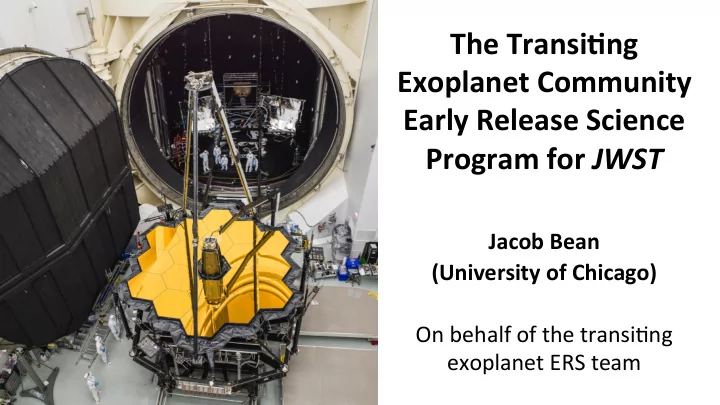

The Transi*ng Exoplanet Community Early Release Science Program for JWST Jacob Bean (University of Chicago) On behalf of the transi/ng exoplanet ERS team
Thanks to the many hundreds of people who con*nue to work towards JWST mission success!
JWST offers myriad instrument setup choices Complica*ons: • entrance apertures • pixel sampling • bright limits • spectral contamina/on • throughput varia/ons • spa/al profile varia/ons • detector gaps • read paAerns • data limits • observatory opera/ons Stevenson+ 2016
JWST data reduc*on will be complex NIRISS + SOSS lab data order 3 order 2 order 1 Wavelength (μm) spectral extrac/on Light curve modeling
Robust correc*on of instrument systema*cs is essen*al 1 x 10 -3 Spitzer /IRAC 4.5μm HD 189733b thermal phase curve Figure adapted from Knutson+ 2012
Robust correc*on of instrument systema*cs is essen*al 2 x 10 -2 1 x 10 -3 Spitzer /IRAC 4.5μm HD 189733b thermal phase curve Figure adapted from Knutson+ 2012
Goals of the transi*ng exoplanet community ERS program • Determine the spectrophotometric /me-series performance of the key instrument modes on /mescales relevant to transits for a representa/ve range of target star brightnesses. • Jump-start the process of developing remedia/on strategies for instrument-specific systema/c noise. • Provide the community a comprehensive suite of transi/ng exoplanet data to fully demonstrate JWST ’s scien/fic capabili/es in this area. For more informa/on see: Program 1377 informa/on at STScI website Bean+ 2018, PASP in revision, arXiv:1803.04985 hAps://ers-transit.github.io
Community Currently 112 team members: 58% observers, 33% theorists community guidance 54% US, 46% EU + Canada 23% women overall 44% women in leadership roles We welcome new team members!
ERS Program 1377: 80 hours of JWST *me! six observa2ons, three planets, four instruments, three transi2ng planet geometries
1. Panchroma*c transmission spectrum of a hot Jupiter (NIRISS + NIRSpec + NIRCam: 0.6 – 5.0 μm, ~40 hrs) WASP-79b: M=0.9 M jup , R=2 R jup , T=1750 K, J=9.3 What is the chemical composi/on of a hot Jupiter? HST data from Showalter+ in prep see poster #45
2. Mid-infrared phase curve of a short-period hot Jupiter (MIRI LRS: 5 – 12 μm, ~30 hrs) WASP-43b: M=2 M jup , R=1 R jup , T=1450 K, J=10.0 dayside How does energy transport and 3D chemistry operate under extreme irradia/on? For more see Venot+ in prep
3. Thermal emission of a hot Jupiter orbi*ng a bright star (NIRISS: 0.8 – 2.7 μm, ~10 hrs) WASP-18b: M=10 M jup , R=1.2 R jup , T=2400 K, J=8.4 What is the chemistry, thermal structure, and energy budget of an ultra-hot Jupiter?
Start of JWST science Target Selec*on assuming a March 30 launch primary targets
These workshops will be open to the en*re community, regardless of Co-I/Collaborator status on the proposal.
Slide courtesy Zach Berta-Thompson
Slide courtesy Zach Berta-Thompson
Timeline
Timeline TESS 2 year mission complete Figure from Rob Zellem See also: Kempton+ 2018 (arXiv:1805.03671)
ERS Program 1377 ERS Program 1386 Transi/ng Planets Direct Imaging Time: 80 hrs Time: 52 hrs (see Hinkley talk tomorrow morning)
ERS Program 1377 ERS Program 1386 Transi/ng Planets Direct Imaging Time: 80 hrs Time: 52 hrs 27% of the allocated ERS /me went to exoplanets!
Recommend
More recommend